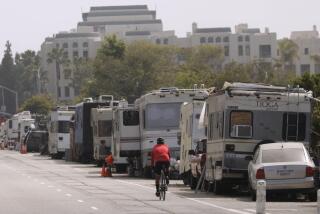Work Begins on Tent City for Homeless
- Share via
As police continued to force the homeless off Skid Row’s streets and sidewalks Friday, Mayor Tom Bradley and RTD officials signed an emergency agreement for a temporary “urban campground” for 600 transients on 12 acres of vacant land near the Los Angeles River.
The encampment plan, rushed through on a 10-0 City Council vote, was the latest attempt by city officials to grapple with the increasingly vexing problem of homelessness. The police sweep of Skid Row, which began Thursday evening, had drawn protests from civil libertarians, but few problems arose during the first night of the operation.
The makeshift tent city, which could open as early as Friday, is on Southern California Rapid Transit District land that will eventually become part of the Metro Rail system.
‘Trying to Be Responsive’
“We are trying to be responsive to a need,” said Bradley as he and RTD board Vice President Carmen Estrada signed the agreement.
Once the document was signed, city bulldozers began grading the land on Santa Fe Avenue near the 4th Street Bridge. Maureen A. Kindel, president of the Board of Public Works, said underground sewer work and other repairs had to be made before tents could be brought in to house the homeless.
Bradley said the encampment, which would be insured by the city’s liability coverage, will be financed by as much as $100,000 in private donations. He said Georgia Frontiere, owner of the Los Angeles Rams pro football team, is among those who have contributed.
But like other attempts to address the homeless situation, the selection of the Santa Fe Avenue land was marked by some controversy. Artists who live and work in nearby warehouses oppose the temporary encampment.
“It’s going to affect . . . our life style,” said commercial photographer Jeff Burke, who lives nearby on 2nd Street.
There was also skepticism on the City Council.
Councilman Gilbert Lindsay, who represents the downtown district, said that though he supports the campground, he is concerned that city policies could attract more and more homeless to Los Angeles--and particularly to downtown.
‘Sympathy Is Running Out’
“My sympathy is running out, I’m telling you,” he said before the vote. “I’m not sympathetic to the ‘y’all come.’ Put them up in the Santa Monica Mountains. That would be a beautiful place for them.”
Aware of the criticism, the mayor tried to downplay it. “We’ll try our best to solve all the problems,” he said.
Meanwhile, squads of Los Angeles police officers continued to sweep through Skid Row on Friday in search of transients. But the situation was pretty much the same as it was when the police operation began Thursday night--there was hardly anyone on Skid Row’s mean streets.
Police Lt. Orley Barton said the scene on Stanford and Towne avenues Friday was in sharp contrast to the litter of sofas, mattresses, discarded food and clothes and “cardboard condos” that the officers encountered Thursday evening. After the officers swept through the area looking for vagrants, city maintenance crews cleared away the debris.
“The streets are beautiful out there,” Barton said.
As of dusk Friday, authorities reported that they had given out 32 county vouchers for four days’ housing that covered 35 people, including three children. Three people were arrested for offenses unrelated to homelessness.
The fact that police had encountered many fewer homeless people than the estimated 1,000 in more than a dozen Skid Row shantytowns led some on Friday to wonder: Where did most of Skid Row’s homeless go to escape the sweeps?
Some transients, aware of the police activity, left for freeway underpasses, Skid Row hotels and vacant lots out of the immediate area. Operators of the so-called “boozer cruiser,” a detoxification station wagon operated by one Skid Row organization, People in Progress, reported transporting a higher-than-usual number of drunks to area hospitals and social agencies.
More to Read
Sign up for Essential California
The most important California stories and recommendations in your inbox every morning.
You may occasionally receive promotional content from the Los Angeles Times.













